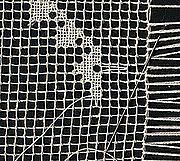
Filet lace
Encyclopedia
Filet lace is a needle lace
created by darning
on a ground of knotted net or netting
.
If we agree that the latin word filatorium (normally translated as Network) is being used to describe Filet lace then Jourdain (1904) quotes a reference to Exeter Cathedral possessing four pieces of Filet lace in 1327. Ingram (1922) states that there was a "cushion of net-work in St. Paul's Cathedral so[sic] early as 1295."
More evidence comes from the publication of a pattern book by Federico de Vinciolo
in 1587 which contains approximately 60 patterns which are suitable for Filet lace.
 As mentioned above Filet lace is created on a ground of knotted net. That ground can either be made by the lace
As mentioned above Filet lace is created on a ground of knotted net. That ground can either be made by the lace
maker or as of 2005 purchased commercially in either handmade or machine-made varieties.
Making the net by hand with a netting shuttle / needle and a gauge involves anchoring the piece, using either a heavy cushion (which Carità (1909) recommends be made of lead) or a stirrup around the workers foot. Having a secure anchor against which to maintain tension a square net is made starting from one corner and adding a new mesh on each row until the desired size is reached, then by decreasing. The individual meshes are formed on a gauge which helps ensure a uniform size and are created by knotting to a loop in the previous round.
The net to be worked on is then stretched taut on a frame and the decorative stitches applied.
Many designs involve blocking out the main design in linen stitch, indeed some designs consist entirely of linen stitch. This creates solid and open areas on the piece. Open areas in the design can then be decorated using a variety of other stiches.
Filet Lace is typically created in a single color of thread, usually white or ecru
, but many countries have used colors.
Needle lace
Needle lace is a type of lace created using a needle and thread to stitch up hundreds of small stitches to form the lace itself....
created by darning
Darning
Darning is a sewing technique for repairing holes or worn areas in fabric or knitting using needle and thread alone. It is often done by hand, but it is also possible to darn with a sewing machine...
on a ground of knotted net or netting
Net (textile)
Net or netting is any textile in which the warp and weft yarns are looped or knotted at their intersections, resulting in a fabric with large open spaces between the yarns....
.
History
Filet lace is a form of decorative netting and as such can be presumed to have derived at some point from the netmaking that a fishing community would require.If we agree that the latin word filatorium (normally translated as Network) is being used to describe Filet lace then Jourdain (1904) quotes a reference to Exeter Cathedral possessing four pieces of Filet lace in 1327. Ingram (1922) states that there was a "cushion of net-work in St. Paul's Cathedral so[sic] early as 1295."
More evidence comes from the publication of a pattern book by Federico de Vinciolo
Federico de Vinciolo
Federico de Vinciolo or Federico Vinciolo was a sixteenth century lace-maker and pattern designer attached to the court of Henry II of France...
in 1587 which contains approximately 60 patterns which are suitable for Filet lace.
Technique

Lace
Lace is an openwork fabric, patterned with open holes in the work, made by machine or by hand. The holes can be formed via removal of threads or cloth from a previously woven fabric, but more often open spaces are created as part of the lace fabric. Lace-making is an ancient craft. True lace was...
maker or as of 2005 purchased commercially in either handmade or machine-made varieties.
Making the net by hand with a netting shuttle / needle and a gauge involves anchoring the piece, using either a heavy cushion (which Carità (1909) recommends be made of lead) or a stirrup around the workers foot. Having a secure anchor against which to maintain tension a square net is made starting from one corner and adding a new mesh on each row until the desired size is reached, then by decreasing. The individual meshes are formed on a gauge which helps ensure a uniform size and are created by knotting to a loop in the previous round.
The net to be worked on is then stretched taut on a frame and the decorative stitches applied.
Many designs involve blocking out the main design in linen stitch, indeed some designs consist entirely of linen stitch. This creates solid and open areas on the piece. Open areas in the design can then be decorated using a variety of other stiches.
Filet Lace is typically created in a single color of thread, usually white or ecru
Ecru (colour)
Ecru describes the shade greyish-pale yellow or a light greyish-yellowish brown. It is often used to describe such fabrics as silk and linen in their unbleached state...
, but many countries have used colors.

